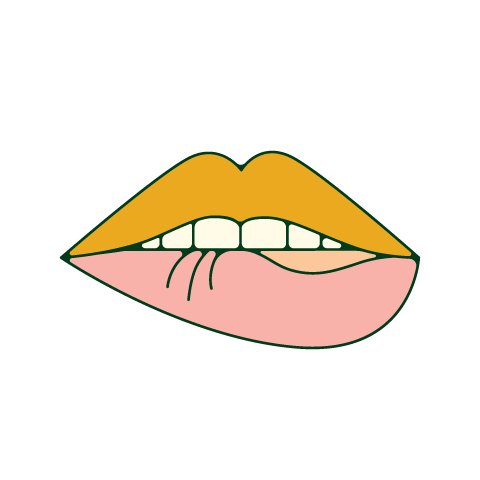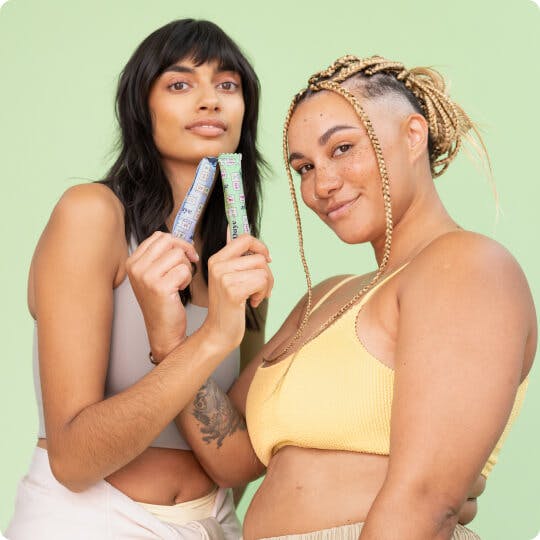Table of contents
1. What is sexual desire?
2. How your menstrual cycle affects sexual desire:
3. Menstrual phase
4. Remember that your body isn’t a machine
Illustrated by Sabrina Bezerra, Erin Rommel & Ralitza Nikolova
Do you have days when you feel super horny and others when your sex drive goes AWOL? If so, that’s totally normal. Sexual desire is complex and there are so many factors that can affect it. One of those is our menstrual cycle. Keep reading to discover how it can affect your libido so you can work in harmony with your natural peaks in sexual desire.
But first…
What is sexual desire?
Also called your libido or sex drive, sexual desire is the product of impulses, thoughts or sensations that motivate us to seek physical pleasure, either with ourselves or other people. In other words, wanting or not wanting sex or intimacy. When you feel desire, solo sex with your vibrator or snuggles with your partner might seem extra appealing.
And just for the record, sexual desire is different from arousal. Whereas desire is about your emotions, arousal refers to your bodily responses when you’re turned on, like increased heart rate, more lubrication, and dilated pupils. While arousal and desire often go hand in hand, your body might feel aroused without you feeling the desire to have sex, and vice versa.
“
Listen to your body and do what feels best for you.
How your menstrual cycle affects sexual desire:
Menstrual phase
In the first phase of your cycle, the menstrual phase, levels of progesterone and estrogen are low. Sensitivity is high because your cervix is dilated during this time, and you have more natural lubrication from your menstrual blood.
During their period, many women experience more intense orgasms due to the increase in blood flow and circulation, all of which can enhance arousal and increase sexual desire.
But this might not be the case for you. Every body is unique, and while sex feels extra good for some during this time, some of us experience a lot of pain and discomfort on our periods, making sex the last thing on our minds. And that’s totally fine.
If you do feel up for period sex though, here’s a fun fact: orgasms are a natural pain reliever! That’s because when you climax your body releases dopamine and serotonin. That combined with the contractions from orgasm can ease cramping and even shorten your period! Hooray!
Summary: The menstrual phase is a mixed bag. While some experience a boost in desire, others have zero libido. Listen to your body and do what feels best for you.
Preovulatory phase
The second phase of your cycle is the preovulatory phase. In this phase your estrogen levels are rising as an egg prepares to be released from your ovaries. Your libido is also steadily increasing as the chemical reactions from your hormones prime your body for a potential pregnancy.
Many women and AFAB individuals report feeling more aroused and having more exciting sexual fantasies during this part of the cycle. Some also report masturbating more frequently and feeling more pleasurable sensations during this time compared to other phases.
If this is the case for you, you might want to schedule a little more “alone time”... to really make the most of increasing desire levels. If you’re looking for some inspiration for your next solo sesh, an app like Emjoy is perfect. With over 400 erotic audio stories, and tonnes of guided masturbation sessions, we’re sure you’ll find something to get you in the mood.
Summary: Schedule a hot masturbation session to make the most of rising desire.

Ovulatory phase
Estrogen peaks just before the ovulatory phase and drops shortly after. This phase only lasts a few days, but for those few days your libido is off the charts!
It’s in this phase that many women report experiencing more consistent and obvious desire. Many also feel more breast sensitivity and experience heightened desire when they’re stimulated. This makes this phase the perfect time to treat the girls to some breast and nipple play.
Sex during the ovulatory phase, also offers more natural lubrication because your body is chemically and physically preparing for a pregnancy.
Summary: A peak in desire levels will likely have you thinking about sex, sex and more sex. So slip on something sexy and release your inner sex goddess.

Luteal phase
The fourth and final phase is the luteal phase. In this phase, progesterone production peaks and then drops.
Many women find they experience a decrease in sexual desire as progesterone levels increase. Plus, it’s totally natural to not feel in the mood if you have premenstrual symptoms like cramping or fatigue.
Summary: You probably won’t be feeling at your sexual peak in this phase, and may be experiencing some PMS. If so, make time for some self-care with Daye’s CBD balm. And if you do feel in the mood for some hanky panky? Go for it!
“
There are many factors beside your menstrual cycle including hormone disorders, antidepressants and much more that can have a significant effect on your libido.
Remember that your body isn’t a machine
While these are some of the ways that your menstrual cycle might affect your desire, remember that every woman is different and our bodies aren’t machines – our menstrual cycle won’t affect us the same way each month. Plus, as we mentioned earlier, there are many factors beside your menstrual cycle including hormone disorders, antidepressants and much more that can have a significant effect on your libido.
One way to see what impacts your sex drive is to note down how your libido evolves through the different stages of your cycle as well as anything else you think could be playing a role. Not only can this help you to figure out the potential triggers for your change in desire, you’ll grow in self-knowledge, which is always very empowering.
And if you feel like you’re suffering from low desire, you can find out more about the causes and how to treat it in this Emjoy collection. Get a free seven-day trial today to access over 800 audio sessions on sexuality, healthy relationships, masturbation techniques and more!


.png?ixlib=gatsbyFP&auto=compress%2Cformat&fit=max&w=1080&h=1080)

